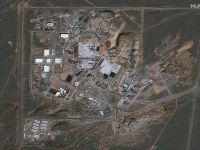ADAC signs AED 10.8 Billion contract with TAV-CCC-Arabtec joint venture for the construction of the midfield terminal building

Abu Dhabi Airports Company (ADAC) and the joint venture (JV) of TAV, CCC, and Arabtec have today signed an AED 10.8 billion contract for the construction of the Midfield Terminal Building (MTB) at Abu Dhabi International Airport, with opening planned in 2017. Construction of the 700,000m2 terminal building, one of the world-class infrastructure projects being undertaken in the capital, will commence in the third quarter of this year.
The project will include two key phases: the 4 year construction phase, followed by the Operational Readiness Assessment phase (ORAT), where during a 9 month period thorough tests of all aspects of the terminal will take place to ensure operational and efficiency readiness from the first day of operation.
Following extensive and ongoing development of the existing airport facilities, the Midfield Terminal Building is the cornerstone of ADAC’s vision to become the world’s leading airport group, delivering highest quality services and infrastructure to serve Abu Dhabi and the world. ADAC is playing a key strategic and operational role in ensuring that Abu Dhabi’s integrated infrastructure system across air, rail, road and sea has sufficient capacity to cater to the increasing numbers of travelers expected as part of the Emirate’s long-term economic and tourism strategies.
On this announcement, Chairman of ADAC, H.E. Ali Majed Al Mansoori, said: "Abu Dhabi Airports Company is looking ahead to an exciting five years of growth focusing on increasing traffic at Abu Dhabi International Airport and on expanding the airport’s infrastructure to support this growth. Leading and supervising the delivery of this mega-infrastructure, whilst managing one of the fastest growing airports in the world, is a defining responsibility for the team; a responsibility central to ADAC’s commitment to provide the best for Abu Dhabi, travelers and airlines.”
Designed by lead designer Kohn Pedersen Fox Associates (KPF) together with Ove Arup, NACO and BNP Associates, the design focused extensively on passenger experience, and meets the highest quality and service standards, including the International Air Transport Association (IATA) level of service ‘A’ - the highest levels of space allocation for passenger processing areas.
During the construction process, the area immediately surrounding the MTB is also being developed to ensure the required infrastructure and facilities are available to support the operation of the MTB in 2017. These include the aircraft parking stands, terminal roadways, connecting roads to Abu Dhabi/Dubai highway, and utility plants. Procurement for these projects is currently underway to ensure delivery in phases between 2014 and 2016.
The MTB is designed to achieve a minimum Two Pearl Rating, following the Urban Planning Council’s Estidama approach towards sustainable design. The project will minimize its impact on the environment, making use of innovative and cutting edge design elements, such as high performance angled glass to reduce heat and increase air-conditioning efficiencies.
Passenger facilities and duty-free retail will include high-end commercial offerings across more than 18,000 square meters, including internationally renowned luxury goods and designer outlets, and almost 10,000 square meters of international restaurants and cafes, offering a wide range of styles and cuisines. Passenger facilities will also include over 27,500 square meters of airline hospitality lounges, a transit hotel and a heritage and culture museum.
Background Information
Abu Dhabi Airports Company
Abu Dhabi Airports Company (ADAC) is a public joint-stock company incorporated by Emiri Decree number 5, of March 4, 2006, to spearhead the development of the Emirate's aviation industry. ADAC’s creation was part of an ambitious restructuring initiative launched by the Government of Abu Dhabi, aimed at delivering better services to support the Emirate’s long-term economic and tourism strategies and to help build a more vibrant economy that attracts and promotes private sector investment.






